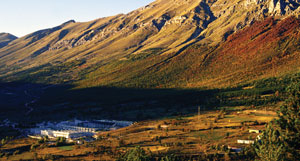 |
| Photo: Francesco Arneodo, LNGS-INFN |
Unharmed in quake, Gran Sasso lab goes to the rescue
When an earthquake flattened buildings in a number of towns across central Italy, physicists turned their focus from research to rescue and rebuilding.
The 6.3-magnitude earthquake on April 14, 2009, killed more than 300 people and left towns near Gran Sasso National Laboratory, a particle physics research center studying neutrinos and dark matter, nearly obliterated. With the laboratory itself mostly unscathed, scientists and engineers rushed to the aid of villagers and the physics department of L'Aquila University.
A laboratory building was quickly converted into a guest house for employees and users who had lost their homes, and space was made to relocate the physics department onsite. With the village of Assergi in rubble, the laboratory offered to shelter the villagers' tent city inside its boundaries. When villagers chose instead to stay close to their damaged homes, the laboratory came to them. Chairs, tables, and just about anything moveable that could improve life in the camps was toted to the nearby village. Lab Director Eugenio Coccia and other staff visited the camp regularly to offer a lifeline of aid and support.
Physicist Roberto Aloisio, who fled the collapse of his own home in L'Aquila, spent the days after the quake searching the rubble for survivors and then, with the help of friends, installing free wireless Internet access for all of the town's tent camps.
Other Gran Sasso employees who lost their homes found temporary shelter in towns outside the earthquake zone, commuting 120 miles or more to work.
The faculty of the university physics department will remain at Gran Sasso for the rest of the year. The laboratory management continues to discuss other ways of helping the university and the villages.
Tona Kunz
Click here to download the pdf version of this article.






